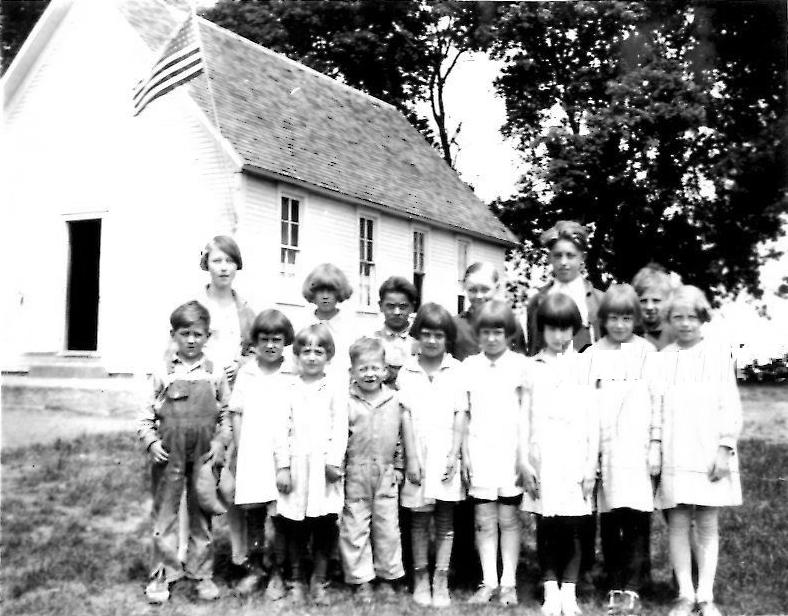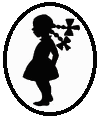
Figure 1.--Here we see Anerican kids in a small rural school which can be seen is the background. The snapshot is not dated, but looks like the the 1930s. Notice that the girls are all wearing dresses. |


|
Strangely given modern standards, younger boys in the 19th century might wear dresses and other skirted garmnts garments, but girls did not wear pants, vonsidered an exclusively man's garment. There were no atual rules, but a strong social convention. Of course we can not say that no girl ever wore pants in the 19th century. There was of course Amelia Bloomers, but Amelia's vlooners did not catch on for women, let alone girls. Some girls may have worn work pamts in rural areas. So it is not impossible that some girls may have worn work pants. But if so it was the exception. And we see no evidence of it in the photographic record. This includes the schools. At the time, chikdren were commonly dressedvup for school. All of this did not change until the 20th century. It did not begin to change to any extent until after World War I in the 1920s. we are not entirely sure of just what brought this change about after centuries of wearing only skirted garments. The most obvious development was WorLd War with its bringing practicality to the fore and women entering the factory work force in unprecedent numbers. We also note younger children, both bys anf girls, being dressed in rompers. The Girl Scouts may have been a factor, especially summer camping. Girls at camp were more likely to wear pants, at first rompers and shorts. For whatever reason, we begin to see girls wearing pants in the 1920s and 30s, especialy the 30s. But this was mostly in casual situations, like playing around the house and at summer camps. We do not see girls commonly wearing pants to school. One might recall Scout in To Kill a Mockingbird set in the 1930s having to wear a dress to school. Now it was not all that common for a girl to only wear pants at home, but Scout had a brother and had lost her mother. But it certainly was the case that few girls showed up at school wearing pants. And the few examples we see are a low income rural schools. World War II had an even greater impact on American life. Women again entered the factory work force and in much larger numbers than in World War I. Again practicalitty came into play. You even begin to see Holloywood startlets wearing pants, albeit glamerous ones. Only in the 1960s, however, do we see girls commonly wearing pants. We see girls beginning to wearing them to school, but not yet to church. Here American girls led the way for a trend that would be followed in other countries. Gradually in the 20th century it became popular for girls to wear boys' styles like shorts and jeans. There was no reciprosity here. In sharp contrast to the 19th century, boys' did not wear girls' styles.
Strangely given modern standards, younger boys in the 19th century might wear dresses and other skirted garmnts garments, but girls did not wear pants, considered an exclusively man's garment. There were no actual rules, but a strong social convention. Of course we can not say that no girl ever wore pants in the 19th century. There was of course Amelia Bloomer, but Amelia's blooners did nor catch on for women, let alone girls,a lthough by the end of rge cenrurt we do see secondary school girs wearing bloomers for gym class--but only for gym. Some girls may have worn work pamts in rural areas. So it is not impossible that some girls may have worn work pants. But if so it was the exception. And we see no evidence of it in the photographic record. This includes schools photography. At the time, children were commonly dressed up for school.
All of this did not change until the 20th century. It did not begin to change to any extent until after World War I in the 1920s. we are not entirely sure of just what brought this change about after centuries of wearing only skirted garments. The most obvious development was WorLd War with its bringing practicality to the fore and women entering the factory work force in unprecedent numbers. We also note younger children, both boys and girls, being dressed in rompers. The Girl Scouts may have been a factor, especially summer camping. Girls at camp were more likely to wear pants, at first rompers and shorts. For whatever reason, we begin to see girls wearing pants in the 1920s and 30s, especialy the 30s. But this was mostly in casual situations, like playing around the house and at summer camps. We do not see girls commonly wearing pants to school. One might recall Scout in To Kill a Mockingbird set in the 1930s having to wear a dress to school. Before World War II we do not see many girls wearing pants to school, even in rural areas (figure 1). Now it was not all that common for a girl to only wear pants at home, but Scout had a brother and had lost her mother. But it certainly was the case that few girls showed up at school wearing pants. And the few examples we see are a low income rural schools. World War II had an even greater impact on American life. Women again entered the factory work force and in much larger numbers than in World War I. Again practicality came into play. You even begin to see Holloywood startlets wearing pants, albeit glamerous ones. Only in the 1960s, however, do we see girls commonly wearing pants. We see girls beginning to wearing them to school, but not yet to church. Here American girls led the way for a trend that would be followed in other countries. Gradually in the 20th century it became popular for girls to wear boys' styles like shorts and jeans. There was no reciprosity here. In sharp contrast to the 19th century, boys' did not wear girls' styles.
Navigate the Historical Girls' Clothing Web Site:
[Return to the Main American girls garment pants page]
[Return to the Main American boys pants page]
[Return to the Main American girls garment page]
[Return to the Main American girls page]
[Return to the Main girls country page]
[Return to the Main girls page]
[About Us]
[Activities]
[Biographies]
[Chronology]
[Color]
[Countries]
[Difficult images] >> combine w/ photo interprtation
[Fashion]
[Families]
[Garments]
[Gender conventions]
[Hair]
[Literature]
[Photo intrpretation]
[School]
[Sisters]
[Return to the Historical Girls Clothing Home Site]
